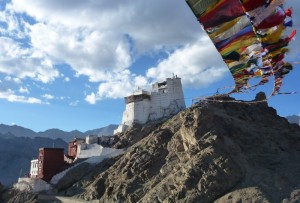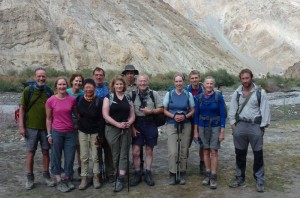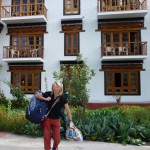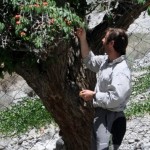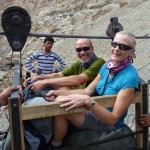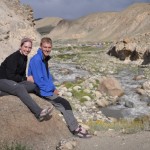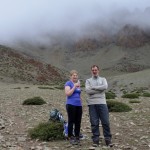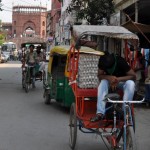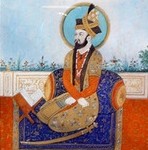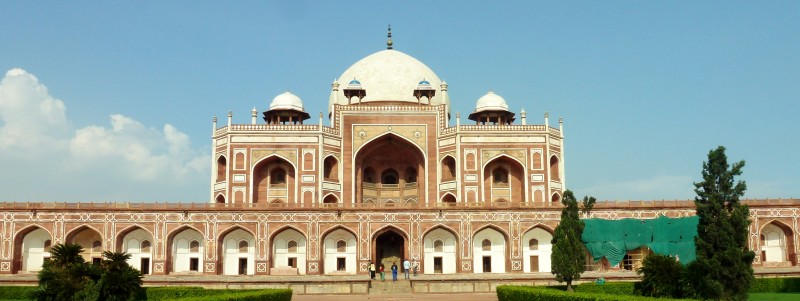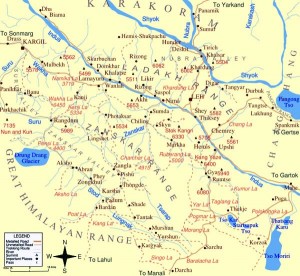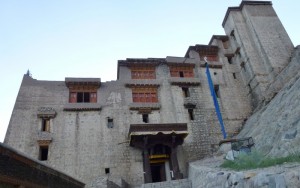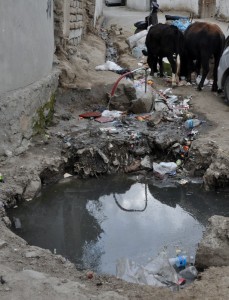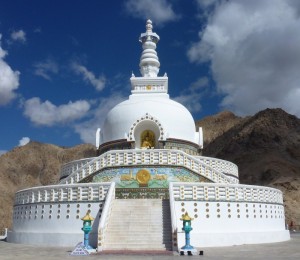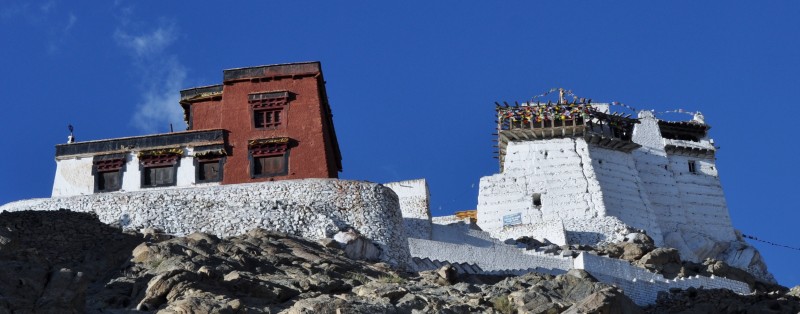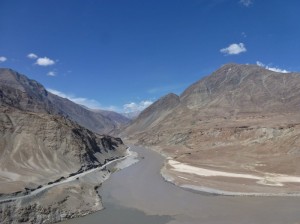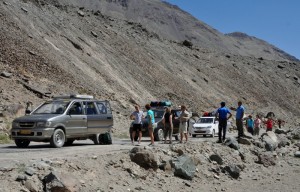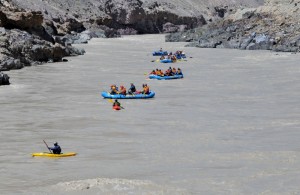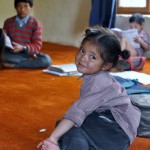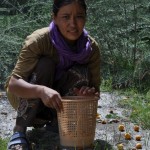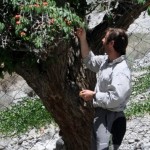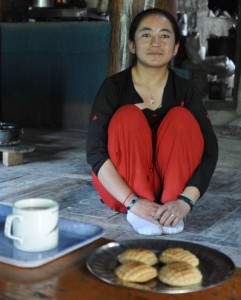Pre-trek: From Delhi to Leh August 3-9
I first heard about Ladakh (“land of high passes”) when planning a studying trip to India, Nepal and Bangladesh in 1978. It sounds fascinating and has been on my wish-list for years. I found a 21-day tour to Ladakh including a 2-week trek in the Markha Valley and an ascent to Stok Kangri (6120m). Though I did not make my way to my first ever 6000-m peak, I was impressed by Ladakh’s natural scenery and monasteries.
August 3 Saturday: Hong Kong – Delhi (GMT +5:30hr)
The flight from Hong Kong to Delhi took less than five hours. I arrived at the airport in Delhi after 9pm. By the time I went through the immigration and collected my luggage, it was almost 10:30pm. This was my fourth visit to Delhi. The airport has been renovated since my last visit in 2005 and looks modern with better facilities.
I expected the local agent waiting for me at the arrival hall. Though there were two dozen of men holding boards and waiting for their clients, I could not see my name. Fortunately, a young man came to my rescue and offered to call the agent for me. After waiting for over an hour, an apologetic nice young man arrived and drove me to the hotel in Karol Bagh, a mixed residential-cum-commercial neighbourhood in Delhi about 20 km from the airport. Apparently, there was a communication gap between the UK office and the local agent. I arrived at Florence Inn Hotel at 12:30am. I was dead tired!
August 4 Sunday: Delhi
I got up early and had a light breakfast. As the local agent had booked Florence Hotel for the group, I had to change hotel. When I arrived at the hotel at 9am, I met Ingrid the tour leader from the UK who told me there would be a group meeting over lunch at 12:30pm. I was pleased to meet 11 members (Margaret & Ian, Pip & Collins, Val & Dave, David, John, Penny, Marion and Shaun). They all arrived from the UK that morning and looked exhausted.
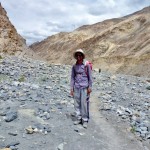
|
New Delhi the capital of India is an enormous urban agglomeration with a population of over 21 million people. The foundation stone of the city planned by two leading 20th-century British architects, Sir Edwin Lutyens and Sir Herbert Baker was laid on 15 December 1911. Structured around two central promenades called the Rajpath (i.e. King’s Way stretching from the Rashtrapati Bhavan (formerly known as Viceroy’s House) to the India Gate) and the Janpath (Path of the People beginning at Connaught Circus where 12 separate roads lead out of the outer ring of Connaught Place), New Delhi is the microcosm of India and home to three World Heritage Sites: Humayan’s Tomb, Red Fort and the Qutub complex.
In the afternoon, we began our city tour at the atmospheric Old Delhi which had been the seat of Delhi Sultanate for centuries. The Mamluk dynasty (1206-90), the Khalji dynasty (1290-1320), the Tughlag dynasty (1320-1414), the Sayyid dynasty (1414-51) and the Lodi dynasty (1451-1526) all ruled from Delhi.
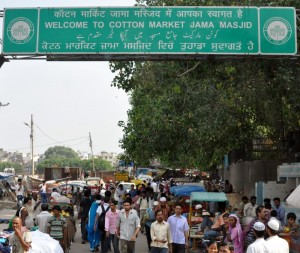 |
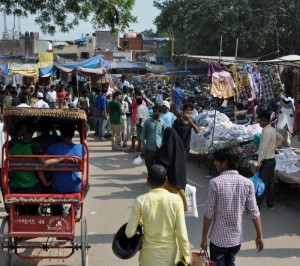 |
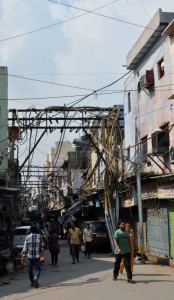 The walled city of Delhi was founded by Mughal Emperor Shan Jahan in 1639. It remained the capital of empire till the end of the dynasty. We passed the imposing Red Fort before arriving at the Jama Masjid (1650-1656), the principal mosque of Old Delhi commissioned by Shan Jahan (1592-1666) who was the fifth Mughal Emperor reigning from 1628 to 1658. Entry is free but one has to pay 300 rupees for the camera. I left my SLR in the coach. I had no intention to take pictures but had forgotten to take my small Leica out of my handbag. The man at the entrance demanded me to pay 300 rupees even without looking at my bag. He was very rude and I left without entering the mosque.
The walled city of Delhi was founded by Mughal Emperor Shan Jahan in 1639. It remained the capital of empire till the end of the dynasty. We passed the imposing Red Fort before arriving at the Jama Masjid (1650-1656), the principal mosque of Old Delhi commissioned by Shan Jahan (1592-1666) who was the fifth Mughal Emperor reigning from 1628 to 1658. Entry is free but one has to pay 300 rupees for the camera. I left my SLR in the coach. I had no intention to take pictures but had forgotten to take my small Leica out of my handbag. The man at the entrance demanded me to pay 300 rupees even without looking at my bag. He was very rude and I left without entering the mosque.
Instead, I spent half an hour strolling around the side streets and watching the people queuing up for food. I first came to the market in Old Delhi in 1978 with Paulina when we were on the study tour. I remember the place was vibrant with people selling vegetables, food and herbal tea. I enjoyed the atmosphere and the people. But today, I find the air quality bad and the exhaust gas unbearable. Modern life has created more garbage and the place is filthy, crowded, dilapidated. Noises coming from cars and auto rickshaws (which serve as taxis) are deafening.
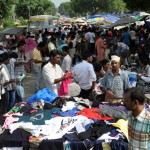 |
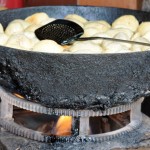 |
 |
Our next stop was Humayun’s Tomb. Humayun (1508-1556) succeeded his father Babur (1483-1530), a direct descendant of Timur from Uzbekistan as the second Mughal Emperor in 1530 at the age of 23. He ruled for ten years before losing the territories and fleeing to Persia. (I recall seeing several panels of mosaic in Isfahan where Shah Tahmasp I received and entertained Emperor Humayun and now have a better understanding of the history of Persia and the Mughal dynasties).
In 1555, Humayun returned from Persia bringing with Persian art, architecture, language and literature to his court. On his sudden death in January 1556 following a fall from a staircase, his son Akbar ascended to the throne ruling an empire covering the present day Afghanistan, Pakistan and part of northern India. Humayun’s tomb was commissioned by his first wife Begq Begum in 1596-70 and was designed by a Persian architect. It was the first garden-tomb in India and the first structure using red sandstone on a large scale.
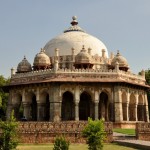 |
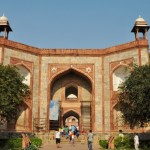 |
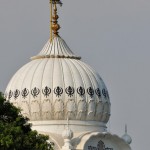 |
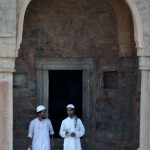 |
The final stop was the showpiece of urban design and the British Empire’s legacy in India. Standing at Sansad Marg, I saw the Rashtrapati Bhavan, the Parliament House, the Secretariat which houses a number of ministries of the Government of India and the India Gate. The local guide an elderly gentleman is sarcastic about members of the Parliament whom he called ‘monkeys’, democracy and developments in his country. I am not surprised as the developments especially in turns of infrastructures in China and India cannot be greater!
It was very hot after 5pm (around 35-37C). We returned to the hotel, had dinner at 7:30pm and went to bed early as we had to get up at 5am!
August 5 Monday: Delhi – Leh
We left the hotel at 5:30am. Only passengers with tickets can enter the airport and the procedures should be simply. Though certain things have improved and the city is served by a metro system, the Indian chaotic feel lingers on.
The plane took off at 8:30am and we arrived in Leh around 10am. I did not sit by the window and missed the scenic views. We were met by Tashi, our local guide and were taken to Hotel Mogul.
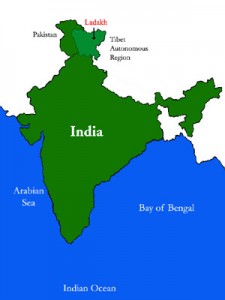 |
Ladakh lying between the Kunlun mountain range in the north and the main Great Himalayas to the south is in the Indian state of Jammu and Kashmir. Ladakh with an area of 86,904 km2 is sparely populated with only about 300,000 people.
Information about Ladakh before the establishment of its first kingdom by Nyima-Gon, a representative of the ancient Tibetan royal house during the 10th century is scanty. Often known as “Little Tibet”, Ladakh has been under strong cultural influence from Tibet. Politically, Ladakh was divided into Lower Ladakh ruled by a king from Basgo and Temisgam and Upper Ladakh by another king from Ley and Shey. Subsequently, a Basgo king reunited Ladakh and took the surname Namgyal (meaning victorious) and founded a new dynasty that still survives today. King Tashi Namgyal (1555-1575) expelled most Central Asian raiders and built a royal fort on top of the Namgyal Peak. Sengge Namgyal (1616-1642) rebuilt many gompas and shrines including the Hemis Monastary and Leh Palace.
By the beginning of the 19th century, the Mughal Empire had collapsed and Sikh rule had been established in Punjab and Kashmir. In 1843 King Tshespal Namgyal was dethroned and exiled to Stok. Ladakh was incorporated into the state of Jammu and Kashmir in 1846.
Ladakh became part of the Indian state of Jammu and Kashmir in 1947. One year later, Pakistani raiders invaded Ladakh till the arrival of reinforcement troops. Ladakhis had been pressing the Indian government to grant the status of a Union Territory and were given their own Autonomous Hill Development Council in 1995. Owing to its strategic location, the India military maintains a strong presence in the region.
Inhabitants of Ladakh are people of Indo-Aryan and Tibetan descent. A majority of Ladakhis are Tibetan Buddhists and the rest are mostly Shia Muslims. Ladakh had gained importance from its strategic location at the crossroads of important trade routes. But international trade has dwindled following the closure of the border in 1962 during the Sino-Indian war. Tourism has however flourished as a result of Indian government’s efforts since mid-1970s. In 2010, 77,800 tourists arrived in Leh.
Leh (3500m) located in the Indus river valley is at a crossroad of the old trading routes between Kashgar, Tibet and Kashmir. The principal access roads include the 434km Srinagar-Leh Highway and the 473 km Leh-Manali Highway. Leh has a cold desert climate with harsh winters from October to March.
I am wary of altitude and acclimatisation is important. I therefore rested for hours after lunch and only took a leisure stroll in the town centre after 4pm. Leh has a compact town centre which is full of mud brick houses, narrow lanes, markets/bazars, souvenir shops, guesthouses, restaurants and travel agents. I find the most interesting and authentic market is the one on the main street where several dozens of Tibetan and Ladakhi women sold fresh apricots, fruits and vegetables on the pavement. They all wear colourful traditional costumes.
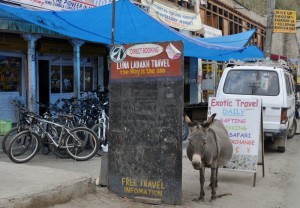 |
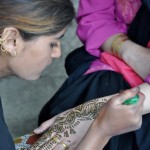 |
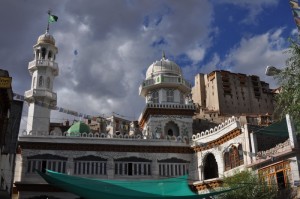 |
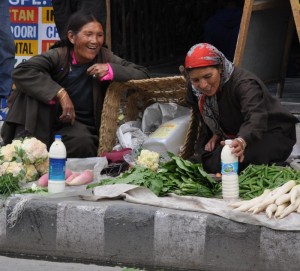 |
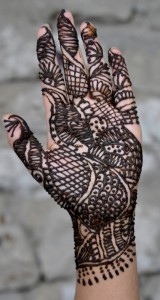 |
I went to bed early as I was tired. I woke up with a slight headache around 3am: the room was stuffy and I did not feel well. I knew I was in trouble!
August 6 Tuesday: Sick Day in Leh
I was reluctant to get up for breakfast at 8am. I had no appetite but I forced myself to drink plenty of water. I informed Ingrid of my condition and told her I would take a rest instead of joining the group to visit the monasteries at Shey, Thikse and Hemis.
Around 10am, I vomited. As the room was hot and airless, I stayed in the cool restaurant and lay down on a bench. I had a slight temperature and was moaning: the staff became concerned about my condition. I dozed off on and off and vomited for the second time around 5pm. I decided to see a doctor.
Accompanied by Ingrid and Tashi, I went to a clinic on the main street opposite the Leh Mosque. It’s quite an experience: I took a token (No 22) and had to wait an hour and a half for my turn. The young Indian doctor looks competent. I had no temperature then and the doctor said I had ‘gas’ in my stomach. He gave me three kinds of tablets and advised me to rest the following day. Consultation and the medication only cost 360 rupees (US$6).
My stomach was more settled: I had a bowl of plain rice and stopped vomiting. The hotel management found me a cooler room on the ground floor and I had a good sleep.
August 7 Wednesday: Rest Day in Leh
The group left for whitewater rafting on the Indus at 9am. I love water-rafting but had to rest in the hotel. I felt better and had rice and steamed vegetables for lunch. Fortunately, I can always keep myself occupied as I have to work on the travel notes and photos. In the afternoon, I went to a computer centre to upload the ‘Epilogue’ on my trip to Russia to my website. The service was cheap i.e. 45 rupees for 30 minutes. But the service was slow and frequently disrupted by power cuts.
Time went quickly. The group had a great time on the Indus. We had a good dinner and I felt much better. I was ready for action!
August 8 Thursday: Sightseeing in Leh
I got up before 6am after an excellent sleep. Tashi arranged a drive to the Khardung La (5380m) which leads into the Nubra Valley close to the border with China. For security reason, Chinese are not allowed to enter this area as well as the Phangong Lake region! What a shame! Half of the group took the drive with Tashi. They said the views of the Zanskar mountain range beyond the Indus Valley are fabulous.
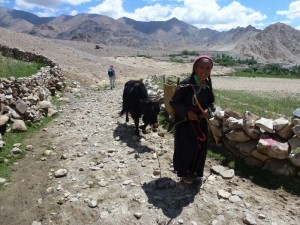 |
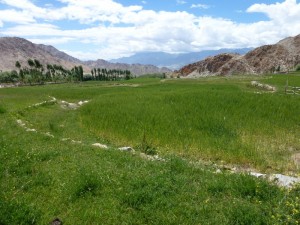 |
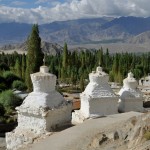 |
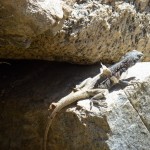 |
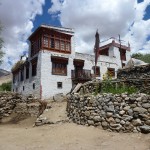 |
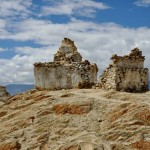 |
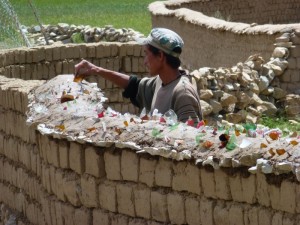 |
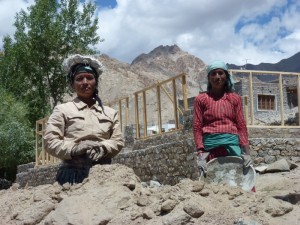 |
I had to join the walking group led by Teniz and visited the Shanti Stupa (4267m) on a hilltop in Chanspa. The white-domed stupa built by a Japanese Buddhist to commemorate 2,500 years of Buddhism and to spread the message of peace was inaugurated in 1985. It holds the relics of the Buddha at its base, enshrined by the 14th Dalai Lama himself. We walked in the picturesque Chanspa valley which cultivated fields were separated by stone walls. I walked slowly and stayed at the back. Then I missed the group at a cross-road. I walked up and down the path three times before I could find the group again. We returned to the hotel for a hot lunch at 1:30pm.
As the sun was hot, I did not go out till 4:30pm. I made my way slowly to the Namgyal Tsemo Gompa built in 1430 by King Tashi Namgyal on a cliff behind the Leh Palace. Before reaching the Gompa, I went into a red-coloured Maitreya (Future Buddha) temple. The Gompa is small but amazing: it has a three-storey high gold Buddha and a rich collection of ancient manuscripts and frescoes. There is also a statute of Avaloketesvara and Manjushri approximately one-storey high. There are many associated temples adjacent to the Gompa above which is a ruin of an old fort. It was a clear day and the views were magnificent: I could see Stok Kangri, the town of Leh, the Zanskar range in the south and the Ladakh range in the north.
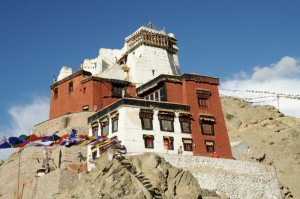 |
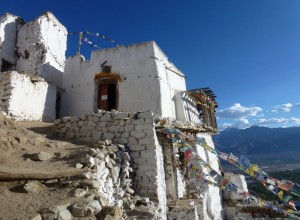 |
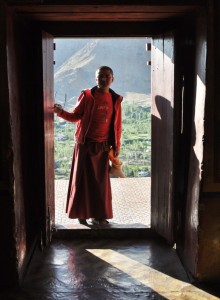 |
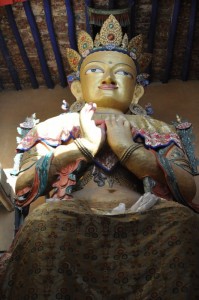 |
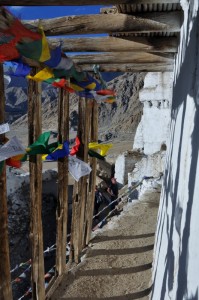 |
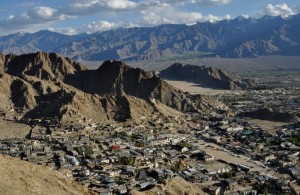 |
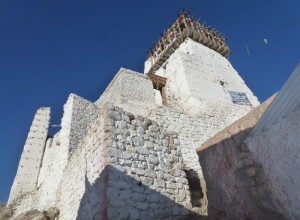 |
The path from the Gompa to the Leh Palace is easy. I reached the palace museum at 6pm. Modeled on the Potala Palace in Lhasa, it was built by King Sengge Namgyal in the 17th century. The royal family moved to Stok Palace when Dogra forces took control of Ladakh in the mid-19th century. The derelict palace has been partially restored by the Archaeological Survey of India but more work needs to be done. There was a photo exhibition of old Ladakh. The directional signs inside the palace are very poor. Unfortunately, there was no lighting and it was too dark to see. I did not have a torch. What a pity!
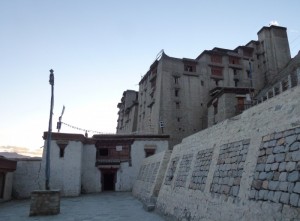 |
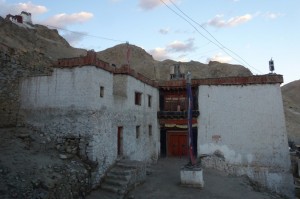 |
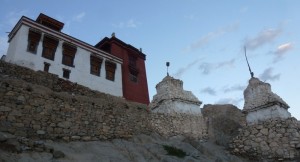 |
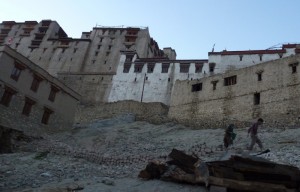 |
Today, I walked about six hours and did not feel tired. I was ready for the trek!
August 9 Friday: Leh – Chilling by car (3 hours)
We set off in four vehicles after breakfast. After driving some 40km along a tarmac road towards Srinagar and Kashmir, we crossed the Indus and drove on a dirt road following the left bank of the Zanskar River through a gorge to Chilling. The gorge is impressive and the river is fast-flowing. Water rafting is popular and some agents run 3 day-2 night water rafting trips on this river. I love the idea!
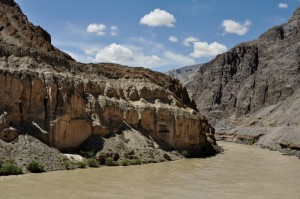 |
The whole journey took about 3 hours. Our first camp site has no open view but there is an apricot tree in the field. I picked the ripe ones which were sweet and juicy. I could not stop and had more than 20 apricots before lunch!
After lunch, I visited the village which is famous for the skill of its silversmiths. I explored this picturesque village on foot. I found a temple which was closed. The village school was open and I spoke with a young teacher who speaks English. There are only seven families in the village and the school has eight pupils and two teachers.
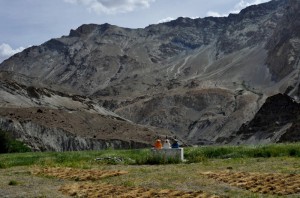 |
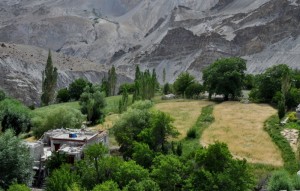 |
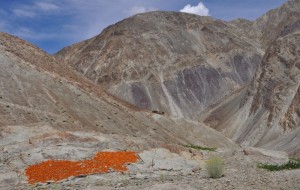 |
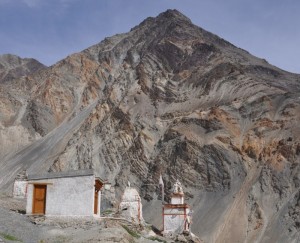 |
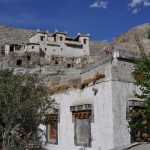 |
Each family has a plot of land for cultivation. It’s the apricot season and villagers were drying apricots on the roof top or open field. Then I met Ian who took me to a family which makes silver spoons. I brought a spoon for 200 rupees from a young girl who later invited Ian and me to visit her house and served us butter tea and home-made biscuits.
She is 17 years old and lives with her grandparents and parents. Her elder brother and sister are both away in Leh. Arranged marriage is not the norm: girls choose their husband and marry around 25 years old. I enjoyed talking with her and discovered the simple life in the
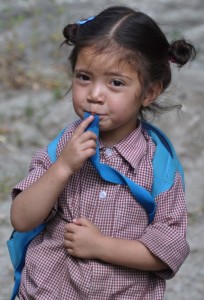 |
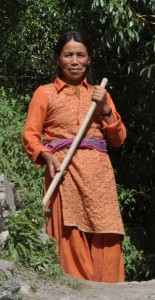 |
Tashi introduced me to the cooking team which prepared our meals in a large cooking tent. We had our first three-course dinner (i.e. soup-main course-dessert) at 7pm. I went to bed before 9pm and had a good sleep as there was no noise except the soothing and gentle sound from the running water from the Zanskar River.


